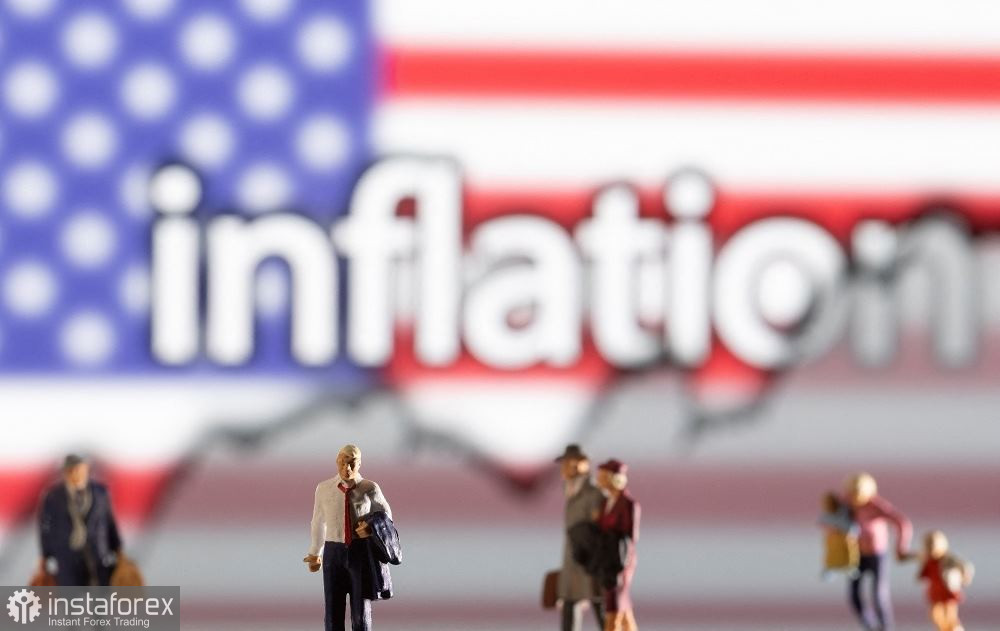The upcoming trading week promises to be "hot". The economic calendar is full of important fundamental events, among which inflation reports and the FOMC minutes should be highlighted. These reports are important for different reasons, but in the light of current circumstances, they have a special significance.
Over the past few weeks, hawkish expectations regarding the Federal Reserve's further actions have been noticeably fluctuating: the balance was tilting either towards a wait-and-see position or towards another 25-basis point rate hike. Friday's Nonfarm Payrolls report suggested that the Fed might still make another hawkish move: the probability of a rate hike at the May meeting increased to 70% (according to CME FedWatch Tool). This fact provided some support for the dollar across the market.

However, upcoming reports could significantly "redraw" the fundamental picture, not in the context of the "rate hike or rate remaining unchanged" dilemma, but in the context of a possible interest rate cut in the second half of this year. This scenario has been discussed by many experts since before the March FOMC meeting, when Fed Chairman Jerome Powell stated that this scenario was "not the base case". Disappointing ISM indices have only fueled interest in this issue. If March inflation in the US ends up in the "red", dovish rumors will only intensify, and the greenback will come under additional pressure.
Inflation, inflation, and inflation again
So, several key inflationary reports will be published in the US this week. The most significant of these is the consumer price index, which will be released on Wednesday, April 12. According to preliminary forecasts, CPI will maintain a downtrend, while core CPI may increase (primarily due to rising housing prices). Thus, according to most experts, CPI will come in at 6.2%. In this case, the indicator will demonstrate a downtrend for the ninth (!) straight month. The market will focus on the core index, which excludes food and energy prices. Here, a small increase is expected - both in annual and monthly terms. In particular, core CPI should come in at 5.6% in annual terms. In this case, a five-month consecutive decline will be interrupted. The renewed growth of the core index may temporarily strengthen the dollar's position across the market (similar to the dollar's reaction to the Non-Farm Payrolls).
Also, the producer price index will be published (Thursday, April 13) this week. Remember that this indicator can signal changes in inflationary trends. According to most experts, PPI will decrease to 3.1% YoY (a decrease for the eighth straight month), while the core index will decrease to 3.3% YoY (a consecutive decline for the last 11 months). If the PPI comes out in the red, the dollar will be under more pressure.
Another inflation report to watch out for is the import price index (Friday, April 14th). Although this report is secondary, it can complement the fundamental picture. Analysts predict a sharp decline in the annual index to -3.7%.
In addition, traders should pay attention to the consumer sentiment index calculated by the University of Michigan. After three months of growth, the index showed a downtrend in March, falling to 62. In April, a decline in the index is also expected, to 61.4 points.
Fed minutes
On Wednesday, April 12, the minutes of the Fed's March meeting will be published. Despite dovish rumors circulating at the time, the Fed raised the interest rate by 25 bps. However, just a few weeks before the March meeting was the downfall of SVB bank, causing turbulence in the US banking sector.
The median Fed forecast, updated at the March meeting, suggests another rate hike this year. But according to some analysts, another move towards monetary tightening is rather optional, depending on whether inflation starts to pick up again. The tone of the minutes will allow for an assessment of the sentiment among the members of the Fed. If most members make hawkish remarks, the dollar may receive some (but temporary) support. But if the rhetoric takes on a "concluding" tone, the greenback will once again face selling pressure. In this case, the market will resume talks about the central bank ending (or pausing) the cycle of monetary tightening at the current level. The pendulum will swing towards a wait-and-see position in May, and this will weigh on the US currency.
Conclusion
As we can see, preliminary forecasts suggest that inflation indicators will continue their downtrend (with the possible exception of the core CPI). In this case, the market will start to doubt whether the Fed will decide on another interest rate hike at the May meeting, especially if the reports turn out to be in the red. The FOMC minutes, even if hawkish, in my opinion, will provide only temporary support to the greenback, as only one additional (final) 25 bps rate hike is at stake. Possible hawkishness of the minutes will be offset if the inflation indicators fall short of forecasts.
Overall, in the near future, bulls will face a very difficult task, for which powerful information drivers are necessary. Any doubts about the prospects of the uptrend will play a fatal role in achieving the 1.1000 figure. Meanwhile, in order to rise further, not only must bulls formally overcome the 1.1000 target but also to consolidate above this level. Therefore, we can say that the "ceiling" of the current uptrend is the upper line of the Bollinger Bands indicator on the daily chart (the infamous 1.1000 level). If the aforementioned inflation reports come in the red, and the FOMC minutes disappoint dollar bulls, bulls will have a chance to consolidate around the 1.1000 figure.





















